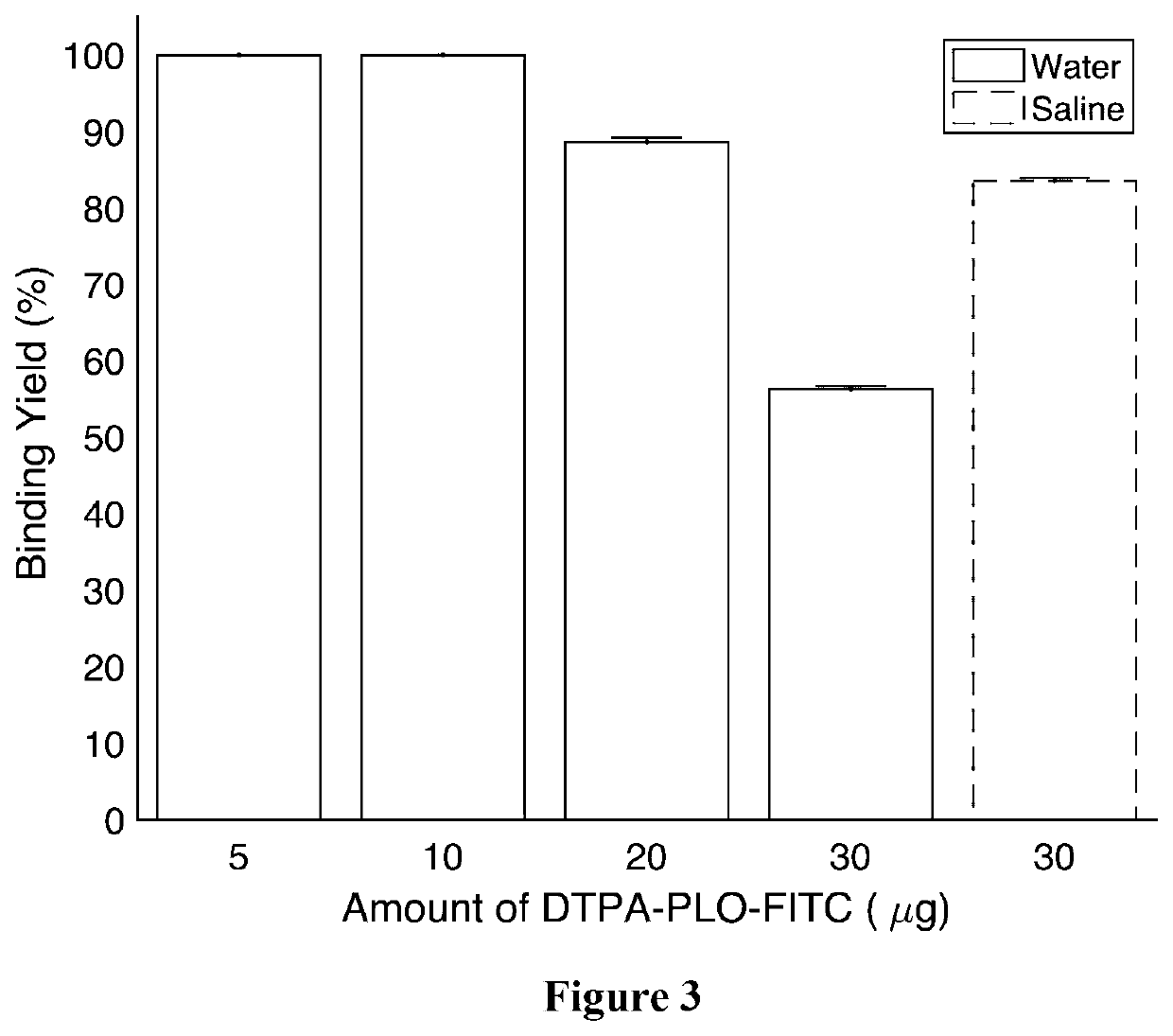Radiolabelled material for targeted administration
- Summary
- Abstract
- Description
- Claims
- Application Information
AI Technical Summary
Benefits of technology
Problems solved by technology
Method used
Image
Examples
example 1
of a Polymeric DTPA-PLO Immobilizing Agent
[0222]Diethylenetriamine pentaacetic acid (DTPA) was covalently conjugated to random primary amino groups along the poly-L-ornithine backbone (PLO, Sigma P4538; molecular weight 5-15 kD), using the 1-ethyl-3-(3-dimethylaminopropyl) carbodiimide (EDC) coupling method (Hermanson, G. T., 2013. Bioconjugate Techniques, Academic Press). For example, PLO (10 mg / mL, 500 μL) was added to a solution of DTPA (20 mM), EDC (20 mM), and sulfo-NHS (10 mM, N-Hydroxysulfosuccinimide) in phosphate buffer pH 7 (0.02 M, 500 μL). The solution was mixed at room temperature for 2 hours and then purified through a PD-10 desalting column (GE Healthcare 17-0851-01).
[0223]FIG. 1 shows a representation of a polymeric immobilizing agent, based on DTPA covalently linked to PLO. The PLO backbone is represented by the coil on the left with pendant substituents of DTPA linked through an amide linkage. Amino groups of PLO that have not been substituted are free to accept pr...
example 2
ng the Molar Ratio of DTPA to PLO for the Immobilizing Agent
[0225]The complexometric indicator Xylenol orange (XO) and its coloured complex with Fe3+ (C. Gay, J. Collins, J. M. Gebicki, Determination of iron in solutions with the ferric-xylenol orange complex, Anal. Biochem. 273 (1999) 143-148. doi:10.1006 / abio.1999.4207) was used to determine the molar ratio of the linked chelator (DPTA) to the polycation polymer (PLO). Known concentrations of the chelate-polycation were added to a known concentration of FeCl3 solution, and the free Fe3+ was determined by the formation of the coloured XO:Fe3+ complex. The sample absorbance's were related to a standard curve of the XO:Fe3+ complex, which is linear with respect to concentrations of Fe3+ in the μM range.
example 3
Fluorescent Tag to the Polymeric DTPA-PLO Immobilizing Agent
[0226]The polymeric DTPA-PLO immobilizing agent may be covalently labeled with other reporter molecules. For example, a fluorescent tag, fluorescein, can be conjugated through a reaction with fluorescein isothiocyanate (FITC, Sigma F4274). Briefly, DTPA-PLO (1.4 mg / mL, 500 μL) was added to a solution of FITC (0.1 mg / mL) in carbonate buffer pH 9 (0.02 M, 500 μL). The solution was left overnight at 4° C., and the reaction was stopped by the addition of 1 M ammonium chloride (50 μL). The fluorescently labeled polycation was purified through a PD-10 desalting column (GE Healthcare 17-0851-01).
PUM
 Login to View More
Login to View More Abstract
Description
Claims
Application Information
 Login to View More
Login to View More - R&D Engineer
- R&D Manager
- IP Professional
- Industry Leading Data Capabilities
- Powerful AI technology
- Patent DNA Extraction
Browse by: Latest US Patents, China's latest patents, Technical Efficacy Thesaurus, Application Domain, Technology Topic, Popular Technical Reports.
© 2024 PatSnap. All rights reserved.Legal|Privacy policy|Modern Slavery Act Transparency Statement|Sitemap|About US| Contact US: help@patsnap.com










